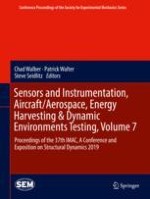2020 | OriginalPaper | Chapter
9. Electromechanical Impedance Method for Applications in Boundary Condition Replication
Authors : Timothy A. Devine, V. V. N. Sriram Malladi, Pablo A. Tarazaga
Published in: Sensors and Instrumentation, Aircraft/Aerospace, Energy Harvesting & Dynamic Environments Testing, Volume 7
Publisher: Springer International Publishing
Activate our intelligent search to find suitable subject content or patents.
Select sections of text to find matching patents with Artificial Intelligence. powered by
Select sections of text to find additional relevant content using AI-assisted search. powered by
